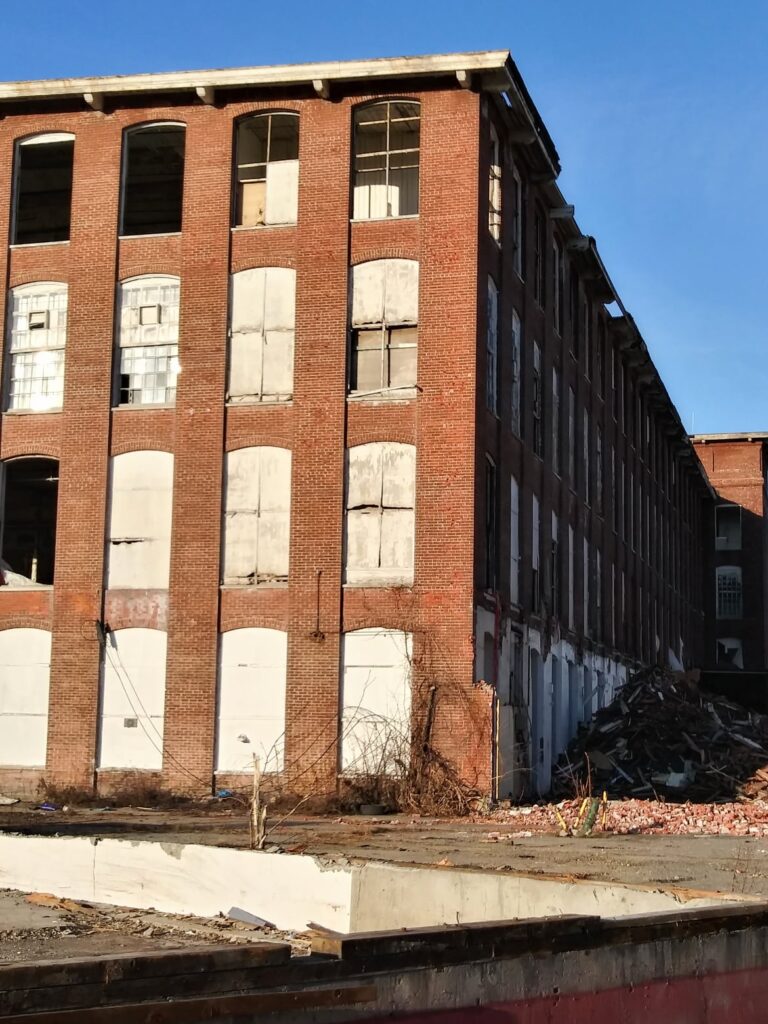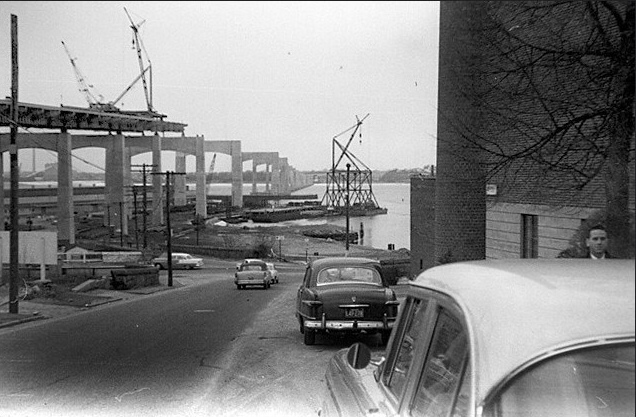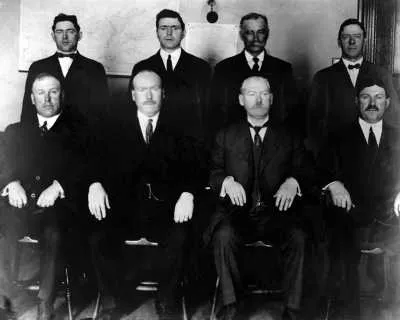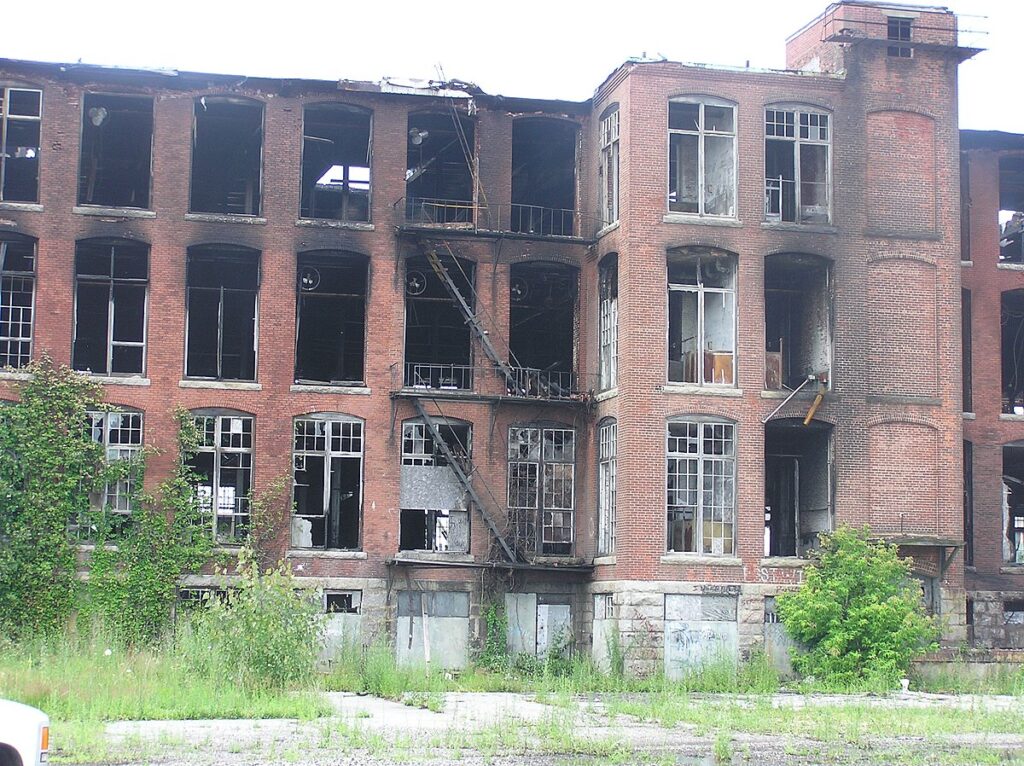Outsourced Pt. 3: Collapse | The South Coast’s Textile Industry

This blog post is part three of a series detailing the history of the South Coast’s textile industry and its impact on social capital. If you have not read the previous entries, please start with part one.
So far, we have covered how innovations in hydropower and industrial loom technology, alongside the inputs derived from whale oil caused a boom of productivity on the South Coast. With this boom came massive disruption to economic norms, the mass-introduction of wage labor, and from that, the birth of the modern labor movement by striking women in the mills. As the 20th century progressed, and the global order of free trade emerged from the ashes of the Second World War, mill corporations who had already been exploiting southern Right to Work laws began looking abroad to cheap labor in the developing world. This tactic of outsourcing was used to crush labor movements and unions in New England, creating a race to the bottom in terms of wages, benefits, and working conditions. The fleeing of capital was so severe that
Confronting Decline
To clean up the bankruptcy, the state of Massachusetts took over Fall River’s finances. The state subsidized large tax breaks to the textile industry in hopes of preventing further relocation southward. While this had some success, it resulted in further straining of the city’s budget. To make up for the difference, the State of Massachusetts imposed austerity measures on the city. Municipal employees went under a 20% pay cut. Many teachers, firefighters, and police officers were laid off. Medical clinics, kindergartens, libraries, and welfare clinics were shut down, and infrastructural construction and maintenance were suspended. These measures lasted well into the 1940s when they were then absorbed into the general austerity measures of World War Two.

While brutal, these tax breaks enticed some companies to stay and even invest in new mills. Another factor was larger, national trends. War-time textile demand, New Deal legislation, and federal minimum wage laws combined with these incentives to make Northern textiles somewhat competitive with the South. With the end of the war, demand for textiles dropped, and the respite ended. Thousands were laid off during the winter of 1948-49 alone, and the city reached over 20% unemployment. Garment shops were always operating alongside textile mills, but with the collapse in textiles, garment shops opened up in the vacancies left. Garment shops had traditionally been female industries. Their owners were hesitant to hire men, and men were embarrassed to enter a “female” industry.
The Beginning of the End
Industry blamed the unions, and union spokesmen blamed management for not investing in innovation to remain competitive. The threat of closing down became a common tactic to quell labor. Massachusetts moved to implement a 50% tax on money made from liquidation, the industry fought back, and a compromise was struck by raising the federal minimum wage for textile workers again. The focus on wages omits the larger picture. The lack of unionization in the South was the real draw for industry. Southern laborers were far more docile in the face of exploitation than the unionized North.
Ultimately, both the threat of, and actual outsourcing were enough to cause the Fall River unions to state they would no longer seek wage increases in 1949. Meanwhile, the local Red Cross was forced to scale back. Modernization of the hospital was pushed back. New construction for schools and the fire department was canceled as the state of the city continued to deteriorate.
The Triumph of Globalism
The Kennedy Round Table Talks in Geneva decreased duties on imported textiles and “sealed the fate” of the industry in America. Now, cheaply made and ethically questionable foreign textiles would flood U.S. markets. Between 1958 and 1966, textile imports from foreign nations increased by 115%. Many shoe manufacturers were forced to switch from manufacturing and selling their own shoes to acting as distributed for cheaply foreign shoes. All of this increased downward pressure on New England’s wages and labor.

Even with some bumps in demand due to the outbreak of the Korean War, the situation was still dire. Unemployment hovered around 11%, with men being displaced, and the number of married women over 45 in the workforce rose to 25%, likely in order for families to pay the bills. Just as the movement south represented a “beta test” for globalization, its impacts represented the first signs of what was to come – an America where one income could no longer support a family.
In yet another omen of the American future, a report from the Council of Economic Advisors to the president stated, “A large part of the adjustment of the depressed areas… can and should be carried out by the local citizens themselves.” In the face of their keystone industry in freefall, the citizens were essentially told to pick themselves up by their bootstraps. During the 1953 city election, one candidate even stated, “If I am elected, I do not honestly feel that it will be in my power to lower unemployment.” By 1954, unemployment was back up to 20%. Those who were not unemployed were often underemployed as mills cut their operations to part-time.
When Work Disappears

With the disappearance of work, Fall River became infested with the “informal economy.” Those who had trouble finding jobs engaged in gambling, bookie shops, and bootlegging. In another look into the future, those who could not find meaningful work in the city began trapping. Trapping is a colloquial term popularized by “Trap Music,” a subgenre of hip-hop. Trapping is a broad term used primarily to describe drug dealing and manufacturing. But can also refer to any other illicit lifestyle common in American ghettos, like jacking cars and robberies. The term is used because those in the ghetto are trapped. With no legitimate way to make a living, they are forced to find illegitimate means. Trapping them in a vicious cycle of poverty, prison, and violence. Places where drugs are created and sold are called “Trap Houses.”
Race to the Bottom
One Fall River resident, who clearly saw the long game of globalization that was about to play out, astutely observed, “Here’s what they tell us folks who work in the mills: You’ve got to come down to the southern level so we can run, then when we get there, they’ll want us to come down to the Puerto Rican level, and after we get there, we have to come down to the Coolie level. I’ve spent 45 years in the mills, North and South. [Workers] are told day in and day out that his job can’t last and is thereby always in fear of that job disappearing.” From the “Coolie” level, outsourcing would take textiles to the Chinese and Bangladeshi levels. Places where workers now make under $5 per day, often much less.

By the end of the 1950s, Fall River’s unemployment rate was far outpacing that of the overall United States. The textile industry never recovered as much of it fled south and began moving abroad. Many textile workers never again worked in manufacturing. They either dropped out of the labor market, fell into the streets, or settled for lower-paid, nonunionized jobs in the service sector like retail cashier or in restaurants – jobs with little to no benefits or retirement plans like the mills once offered.
Between 1948 and 1960, Fall River lost 55% of its manufacturing. The rest of New England, including New Bedford, saw similar drops. With this decline came a decimation of the TWUA. The collapse of New England manufacturing meant fewer resources for the unions. Fewer resources meant they could not fight the already severely uphill battle in the South. So began the systematic outsourcing of industry, liquidation of city coffers, and destruction of unions that would come to define the Neoliberal era in the United States.
Even with this downward pressure, the remaining mills still paid better than the service sector jobs swiftly replacing them. Rather than being seen as an omen of the dystopia to come, the situation in New England was written off by scholars, policymakers, and economists as an anomaly. The fact that New England was not enjoying the post-war prosperity was not seen as a policy problem, nor were the families of Fall River and New Bedford seen as canaries in the coal mine. Rather the narrative became that this was the fault of the New Englanders themselves. It was their fault for not being resourceful enough. Criticism of the emerging global order was seen as unpatriotic and communist.
The End is Just the Beginning
Optimists cheered for textiles to be replaced by “sunrise industries” such as electronics, but history shows electronics were swiftly outsourced to foreign nations, and Japan, South Korea, and Taiwan rose to dominate the industry. In hindsight, we see that the fate of New England’s textile industry was the first domino in a long chain of deindustrialization, corporate consolidation, outsourcing, the destruction of unions in exchange for tyrannical “managerialism,” hollowing out of domestic capability, and a de-skilling of the general workforce. All of this is accompanied by myriad social ills, including increasing divorce rates, lower wages, crime, overdoses, and immense commodification of labor.
In 1940, more than 20% of all workers in New England were employed in the textile, apparel, and shoe industries. By 1977 half of these jobs had been lost. With the destruction of this industry, there was little left to employ those who had worked in the skilled and semi-skilled mill industries. Because work was so reliable during the heyday, many workers only had a high school diploma, if that. Unemployment spiked in once-bustling industrial cities such as Lowell, Lawerence, Fall River, and New Bedford. Between 1959 and 1975, the number of jobs in women’s apparel factories dove from over 80,000 to less than 36,000. Over the same period, a third of the shoe industry was also lost. New England’s unemployment rate over this time was constantly well above the national average as city skylines were lined with shuttered mills.

Broken Promises
This state of affairs was defended as “creative destruction.” The claim that with the demise of these jobs comes the rise of new jobs in new sectors. This utopian tale failed to deliver meaningfully and falls apart under nuanced scrutiny, which reveals much deeper problems. During the 1960s and 1970s, it is estimated that for every new job gained, 2-4 textile jobs were lost.
Looking deeper, those jobs gained were either nonunionized, low-wage service sector jobs or high-paying, high-tech or corporate managerial jobs. These managerial and high-tech jobs are irrelevant to those with a high school diploma and 20 years of experience in the textile industry. Fifty-two-year-old mill workers cannot “learn to code.” Furthermore, the geographic spread of these high-paying jobs tended to congregate in Metro Boston, either out of reach or an obnoxiously long commute from the former mill town. As mills shut down in mill cities, soon followed restaurants, churches, small businesses, and schools.
Stay Tuned for Part 4: A People’s History of Globalization
- Outsourced Pt. 3: Collapse | The South Coast’s Textile Industry - October 4, 2023
- Need an Office for a Day? A Week? On-Demand? Look No Further than Coworking Spaces - September 12, 2023
- Outsourced Pt. 2: Boom & Bust | The South Coast’s Textile Industry - July 31, 2023
